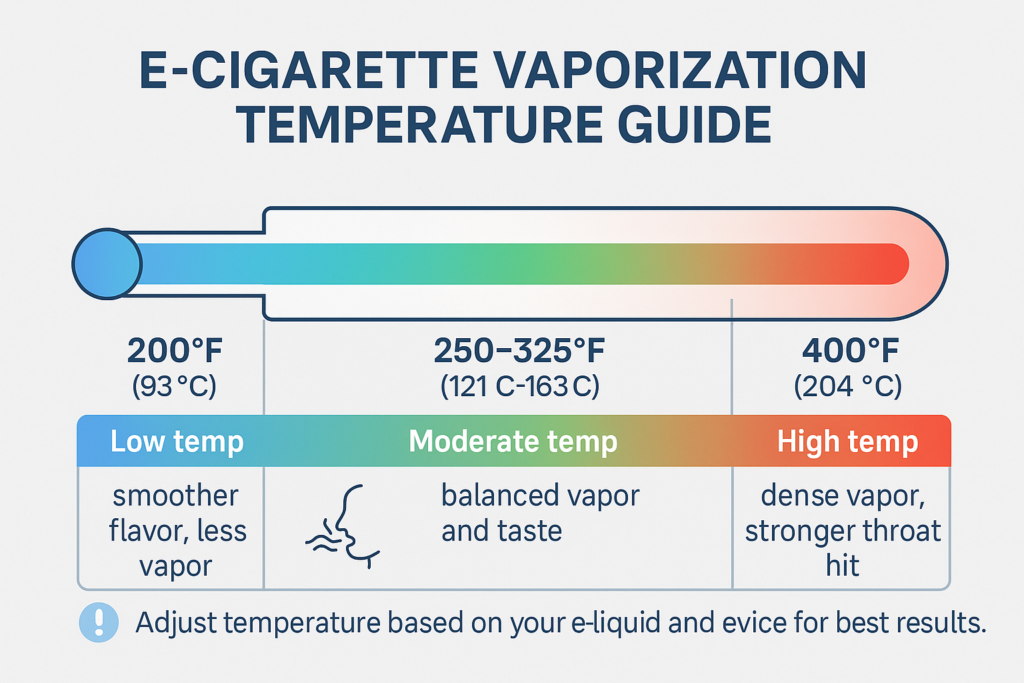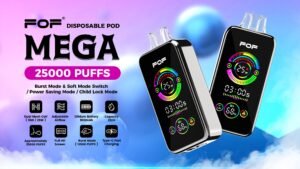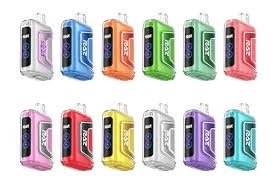Vaping temperature is a key factor in the experience. But what temperature do e-cigarettes actually vaporize at?
Electronic cigarettes typically vaporize e-liquid between 200°F (93°C) and 400°F (204°C). The ideal temperature depends on the e-liquid composition, the device, and the user's preference. Lower temperatures produce less vapor but preserve flavor, while higher temperatures produce more vapor but can create a harsher hit.
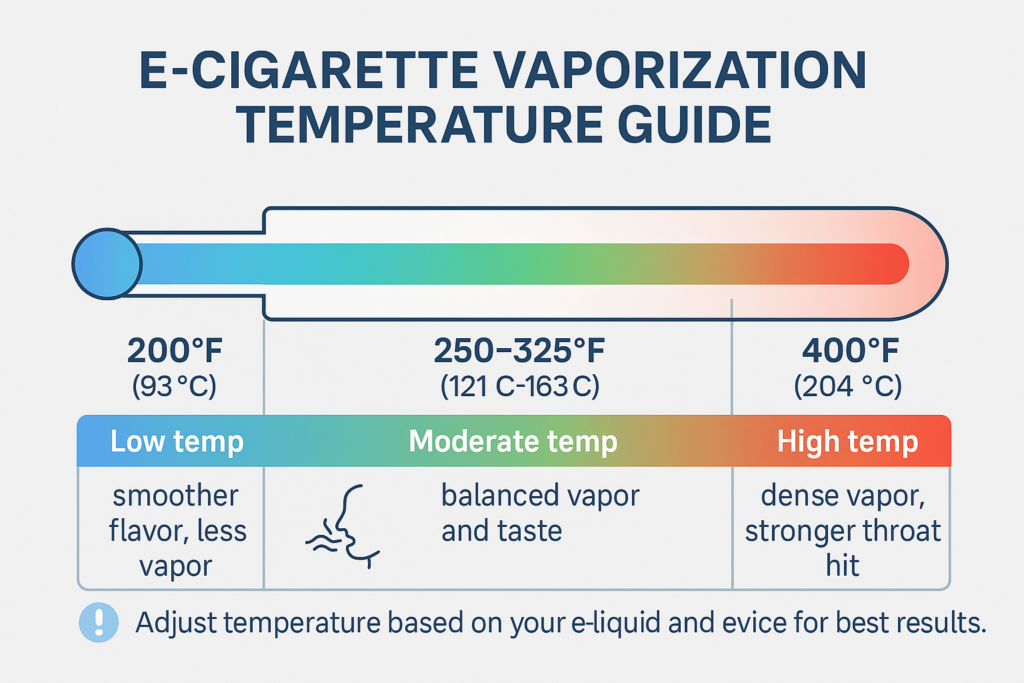
"A visual representation of the relationship between vaping temperature, flavor, and vapor production"
As someone who's been around the vaping block, I know that finding the right temperature is crucial. Let's dive into the details of vaping temperatures and how to optimize them.
What temperature should e cig coils be?
The coil temperature is directly related to the vaporization temperature.
E-cig coils should typically be between 200°F (93°C) and 400°F (204°C). This range allows for efficient vaporization without burning the e-liquid. However, some advanced devices with temperature control settings may allow for slightly higher or lower temperatures, depending on the coil material and e-liquid type.
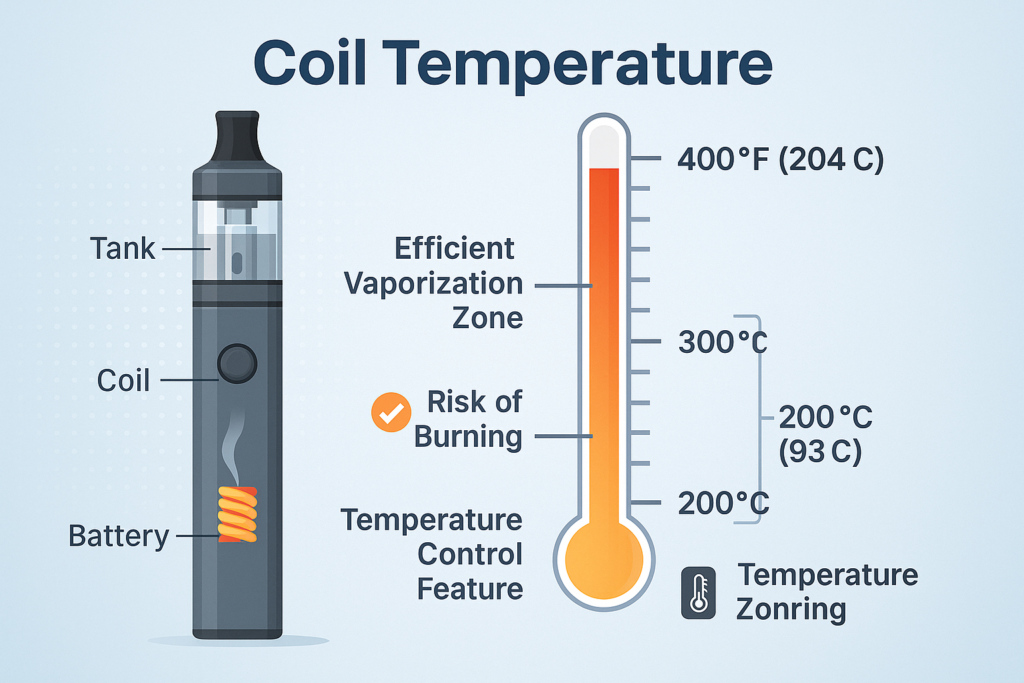
"A detailed view of an e-cig coil heating up, illustrating the importance of temperature control"
The right coil temperature1 is essential for both flavor and safety.
The factors that influence the ideal coil temperature include the coil material, the e-liquid composition2, and the desired vaping experience. Drawing from my understanding of thermodynamics and vaping technology, I've identified the following key determinants. The coil material, such as kanthal, nichrome, or stainless steel, has different heat resistance properties – different coil materials, such as kanthal, nichrome, or stainless steel, have different heat resistance properties, affecting the optimal temperature range for vaping. The e-liquid composition, including the VG/PG ratio and flavorings, affects the vaporization point – the e-liquid composition, including the VG/PG ratio and flavorings, affects the vaporization point, with higher VG ratios requiring higher temperatures for efficient vaporization. The desired vaping experience, such as flavor intensity and vapor production, influences the preferred temperature setting – the desired vaping experience, such as flavor intensity and vapor production, influences the preferred temperature setting, with lower temperatures enhancing flavor and higher temperatures increasing vapor production. The coil resistance affects the amount of power needed to reach the desired temperature – the coil resistance affects the amount of power needed to reach the desired temperature, with lower resistance coils requiring more power and higher resistance coils requiring less power. The airflow also helps with the coil temperature, as the faster the airflow, the less heat the coil gets - the airflow also helps with the coil temperature, as the faster the airflow, the less heat the coil gets.
The potential problems that can arise from using too high or too low coil temperatures include dry hits, burnt taste, and reduced vapor production. Through analyzing user feedback and technical specifications, I've identified the following key challenges. The dry hits can occur when the coil is too hot and the e-liquid is vaporized too quickly – dry hits can occur when the coil is too hot and the e-liquid is vaporized too quickly, resulting in a harsh, unpleasant taste. The burnt taste can result from the e-liquid overheating and breaking down – the burnt taste can result from the e-liquid overheating and breaking down, releasing harmful chemicals and creating an acrid flavor. The reduced vapor production can occur when the coil is not hot enough to efficiently vaporize the e-liquid – reduced vapor production can occur when the coil is not hot enough to efficiently vaporize the e-liquid, leading to a weak and unsatisfying vaping experience. The coil damage can result from excessive heat and prolonged use – coil damage can result from excessive heat and prolonged use, reducing the lifespan of the coil and affecting its performance. The leaking can result from the e-liquid not vaporizing properly and flooding the atomizer – leaking can result from the e-liquid not vaporizing properly and flooding the atomizer, leading to a messy and unpleasant vaping experience.
The tips for optimizing coil temperature for a better vaping experience include using temperature control settings3, priming coils properly, and adjusting wattage accordingly. Through analyzing best practices and expert recommendations, I've identified the following key strategies. The using temperature control settings to prevent overheating and dry hits – using temperature control settings prevents overheating and dry hits, ensuring a smoother and more consistent vaping experience. The priming coils properly by saturating the wicking material before use – priming coils properly by saturating the wicking material before use ensures that the coil is fully saturated with e-liquid, preventing dry hits and extending the lifespan of the coil. The adjusting wattage accordingly to match the coil resistance and e-liquid type – adjusting wattage accordingly to match the coil resistance and e-liquid type allows users to fine-tune the vaping experience and optimize vapor production and flavor. The cleaning the device regularly to prevent gunk buildup and maintain optimal performance – cleaning the device regularly prevents gunk buildup and maintains optimal performance, ensuring a cleaner and more enjoyable vaping experience. The replacing coils regularly to maintain optimal performance and prevent degradation – replacing coils regularly maintains optimal performance and prevents degradation, ensuring a consistent and satisfying vaping experience.
What temperature should a vaporizer be at?
This depends on what you're vaporizing.
The ideal temperature for a vaporizer depends on the substance being vaporized. For e-liquids, the range is typically 200°F (93°C) to 400°F (204°C). For dry herbs, the range is often higher, between 300°F (149°C) and 450°F (232°C). It's important to consult the manufacturer's instructions for your specific device and substance.
 "A comparison chart showing the optimal temperature ranges for vaporizing e-liquids, dry herbs, and concentrates"
"A comparison chart showing the optimal temperature ranges for vaporizing e-liquids, dry herbs, and concentrates"
Different substances require different temperatures for optimal vaporization.
The optimal temperature range for vaporizing4 different substances varies depending on their chemical composition and desired effects. Drawing from my understanding of chemistry and vaporization science, I've identified the following key considerations. The e-liquids typically vaporize at lower temperatures, between 200°F (93°C) and 400°F (204°C) – e-liquids typically vaporize at lower temperatures, between 200°F (93°C) and 400°F (204°C), to preserve flavor and prevent burning. The dry herbs require higher temperatures, between 300°F (149°C) and 450°F (232°C), to release their active compounds – dry herbs require higher temperatures, between 300°F (149°C) and 450°F (232°C), to release their active compounds, such as THC and CBD. The concentrates, such as wax and shatter, may require even higher temperatures, between 400°F (204°C) and 600°F (316°C) – concentrates, such as wax and shatter, may require even higher temperatures, between 400°F (204°C) and 600°F (316°C), to fully vaporize and deliver their desired effects. The manufacturer's instructions provide specific recommendations for each device and substance – the manufacturer's instructions provide specific recommendations for each device and substance, ensuring optimal performance and preventing damage. The experimenting with different temperatures allows users to fine-tune the vaping experience and achieve their desired effects – experimenting with different temperatures allows users to fine-tune the vaping experience and achieve their desired effects, such as flavor intensity and vapor production.
The potential effects of using too high or too low temperatures for vaporization include combustion, reduced potency, and altered flavor profiles. Through analyzing user feedback and scientific literature, I've identified the following key consequences. The combustion can occur if the temperature is too high5, resulting in the release of harmful chemicals and a burnt taste – combustion can occur if the temperature is too high, resulting in the release of harmful chemicals, such as benzene and carbon monoxide, and a burnt taste. The reduced potency can result from incomplete vaporization of active compounds if the temperature is too low – reduced potency can result from incomplete vaporization of active compounds if the temperature is too low, leading to a weak and unsatisfying experience. The altered flavor profiles can occur at different temperatures, with certain compounds vaporizing at different rates – altered flavor profiles can occur at different temperatures, with certain compounds vaporizing at different rates, affecting the overall taste and aroma. The device damage can result from overheating or using incompatible substances – device damage can result from overheating or using incompatible substances, reducing the lifespan of the device and potentially causing malfunctions. The health risks can increase with the release of harmful chemicals at high temperatures – health risks can increase with the release of harmful chemicals at high temperatures, such as respiratory irritation and potential long-term health effects.
The tips for finding the optimal temperature for your vaporizer include starting low and gradually increasing, consulting online resources, and paying attention to the vapor quality and flavor. Through analyzing expert recommendations and user experiences, I've identified the following key strategies. The starting low and gradually increasing the temperature6 until the desired effects are achieved – starting low and gradually increasing the temperature until the desired effects are achieved allows users to find the optimal setting without risking combustion or overheating. The consulting online resources and forums for tips and recommendations from experienced users – consulting online resources and forums provides access to tips and recommendations from experienced users, offering valuable insights into the best temperature settings for different substances and devices. The paying attention to the vapor quality and flavor to determine the optimal temperature range – paying attention to the vapor quality and flavor allows users to fine-tune the temperature setting for their desired experience. The cleaning the device regularly to prevent residue buildup and maintain optimal performance – cleaning the device regularly prevents residue buildup and maintains optimal performance, ensuring a cleaner and more enjoyable vaping experience. The replacing the heating element as needed to maintain consistent temperature and vapor production – replacing the heating element as needed maintains consistent temperature and vapor production, ensuring a reliable and satisfying vaping experience.
How hot is vape vapour?
The temperature of vape vapor is an important factor in the overall experience.
Vape vapor temperature typically ranges from 100°F (38°C) to 150°F (66°C) as it's inhaled. This is significantly cooler than the smoke from traditional cigarettes, which can reach temperatures of over 900°F (482°C). However, the exact temperature depends on the device, the settings, and the e-liquid.
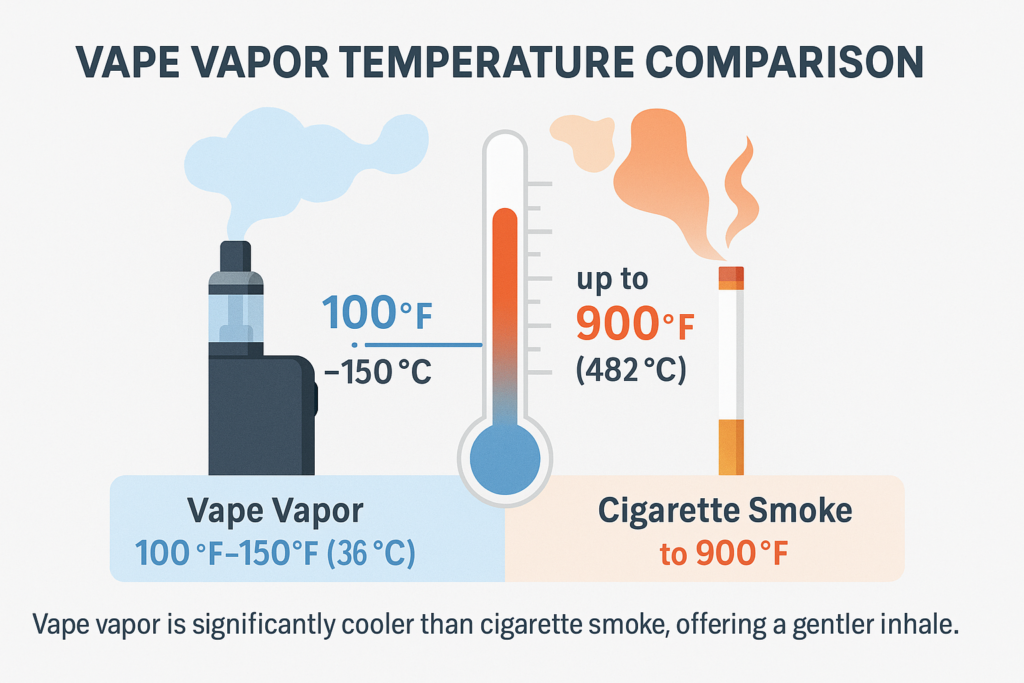 "A visual representation of the temperature of vape vapor as it's exhaled, highlighting the difference from cigarette smoke"
"A visual representation of the temperature of vape vapor as it's exhaled, highlighting the difference from cigarette smoke"
While cooler than cigarette smoke, vape vapor can still be quite warm.
The factors that affect the temperature of vape vapor include the device type, the power settings, and the airflow. Drawing from my understanding of thermodynamics and vaping technology, I've identified the following key determinants. The device type, such as a pod system or sub-ohm tank, affects the vapor production and temperature – the device type, such as a pod system or sub-ohm tank, affects the vapor production and temperature, with sub-ohm tanks typically producing warmer vapor due to their higher power output. The power settings, such as wattage or voltage, determine the amount of heat generated by the coil – the power settings, such as wattage or voltage, determine the amount of heat generated by the coil, directly affecting the vapor temperature. The airflow influences the cooling of the vapor as it travels through the device – the airflow influences the cooling of the vapor as it travels through the device, with more airflow resulting in cooler vapor. The e-liquid composition7, including the VG/PG ratio, affects the heat retention and vapor density – the e-liquid composition, including the VG/PG ratio, affects the heat retention and vapor density, with higher VG ratios typically producing warmer vapor. The inhalation technique, such as direct-to-lung or mouth-to-lung, affects the perceived temperature of the vapor – the inhalation technique, such as direct-to-lung or mouth-to-lung, affects the perceived temperature of the vapor, with direct-to-lung inhalation often resulting in a warmer sensation.
The potential effects of inhaling hot vape vapor include throat irritation8, coughing, and increased risk of burns. Through analyzing user feedback and scientific literature, I've identified the following key consequences. The throat irritation can result from the hot vapor drying out and irritating the delicate tissues in the throat – throat irritation can result from the hot vapor drying out and irritating the delicate tissues in the throat, leading to discomfort and coughing. The coughing can occur as a reflex response to the hot vapor – coughing can occur as a reflex response to the hot vapor, indicating that the vapor is too hot or irritating. The increased risk of burns can result from direct contact with hot components of the device – the increased risk of burns can result from direct contact with hot components of the device, such as the coil or mouthpiece. The altered flavor perception can occur due to the heat affecting the taste receptors – altered flavor perception can occur due to the heat affecting the taste receptors, potentially diminishing the enjoyment of the vaping experience. The increased risk of exposure to harmful chemicals can result from overheating the e-liquid – the increased risk of exposure to harmful chemicals can result from overheating the e-liquid, leading to the release of toxic substances.
The tips for cooling down vape vapor include using devices with adjustable airflow9, lowering the power settings, and choosing e-liquids with higher PG ratios. Through analyzing expert recommendations and user experiences, I've identified the following key strategies. The using devices with adjustable airflow to increase the cooling of the vapor – using devices with adjustable airflow increases the cooling of the vapor, reducing the perceived temperature and minimizing throat irritation. The lowering the power settings to reduce the heat generated by the coil – lowering the power settings reduces the heat generated by the coil, resulting in cooler vapor and a smoother vaping experience. The choosing e-liquids with higher PG ratios, which tend to produce cooler vapor – choosing e-liquids with higher PG ratios produces cooler vapor, as PG has a lower boiling point than VG. The taking shorter puffs to prevent the device from overheating – taking shorter puffs prevents the device from overheating, reducing the vapor temperature and minimizing the risk of throat irritation. The using a longer drip tip to increase the distance between the coil and the mouth – using a longer drip tip increases the distance between the coil and the mouth, allowing the vapor to cool down before it is inhaled.
Conclusion
Vaping temperature matters. Find the right temperature for your device and e-liquid to maximize flavor and minimize harm. Always prioritize safety and consult manufacturer guidelines.
-
Understanding coil temperature is crucial for achieving the best flavor and safety in vaping. Explore this link to learn more about its significance. ↩
-
E-liquid composition plays a vital role in vaporization and flavor. Discover how different ratios impact your vaping experience by exploring this resource. ↩
-
Temperature control settings can enhance your vaping experience by preventing overheating. Learn more about their benefits and how to use them effectively. ↩
-
Understanding the optimal temperature range is crucial for maximizing flavor and potency in vaporization. Explore this link for detailed insights. ↩
-
Learn about the harmful effects of combustion in vaporization, including health risks and flavor degradation. This resource provides essential information. ↩
-
Discover the benefits of starting low in vaporization to avoid combustion and enhance your experience. This link offers expert tips and strategies. ↩
-
Exploring e-liquid composition can enhance your knowledge of vaping and help you choose better products. ↩
-
Understanding throat irritation can help you mitigate discomfort and improve your vaping experience. ↩
-
Learning about adjustable airflow can significantly improve your vaping experience by reducing irritation and enhancing flavor. ↩

